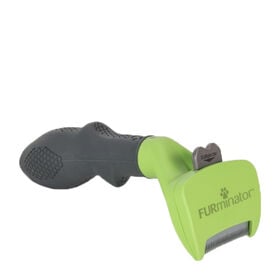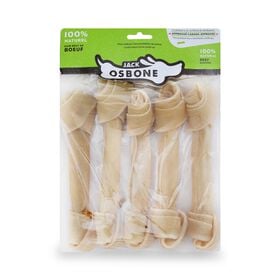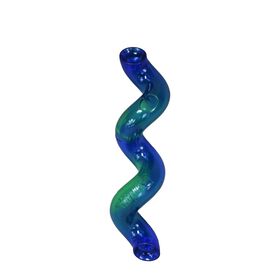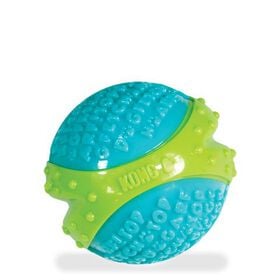Here at home, the Australian shepherd is highly appreciated. In fact, it was even ranked 8th on the top ten list of the most popular dog breeds in Canada in 2019. This breed of hard-working dogs has a great capacity for learning and was even featured in several Disney films.
Origin
The history of the Australian shepherd is vague, as is the origin of its misleading name. Initially, the breed was referred to as Spanish shepherd, pastor dog, bobtail, New Mexican shepherd, California shepherd and Austrian shepherd.
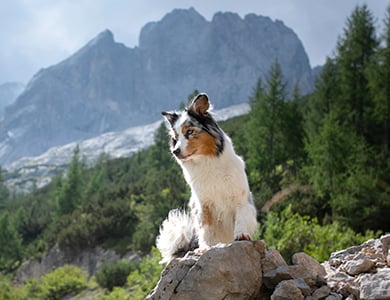
Some have suggested that the breed has Basque (Spain) origins and that it was used by Basque shepherds. It is believed that these shepherds immigrated to the American West Coast via Australia. It is understood that the breed as we know it today was developed in western North America in the 19th century and in the early 20th century, during the Gold Rush. The Australian shepherd was an especially tireless sheep herder in the Rocky Mountains, as it is relatively unaffected by altitude.
Appearance
The Australian shepherd is a well-balanced dog of medium size and bone. Slightly longer than tall, the male stands 20 to 23 inches (50 to 58 cm) at the shoulder, while the female measures between 18 and 21 inches (45 to 53 cm).
Males weigh on average 50 to 60 pounds, and females weigh 40 to 50 pounds. The recognized colours for the breed are black, solid red (liver), blue merle and red merle. Each of these colours may also feature copper (beige) markings or various combinations of white markings on the face, chest and legs.
The Australian shepherd has a thick double coat of fur, predominantly around the neck area and on the thighs, which means that the coat features an undercoat. The coat is straight to slightly wavy but never curly. While some Australian shepherds are born with natural bobbed or missing tails, most are born with full, long tails. To prevent the dogs from being injured while working with livestock, ranchers historically docked the tails. Today, more and more Australian shepherds have a tail that is similar to that of the Border collie, given that several countries now prohibit cosmetic surgeries on dogs.
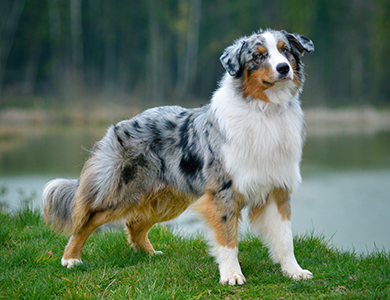
Lifespan and Health
The most common health problems among this breed are vision impairment, deafness, osteochondritis desicans (OCD), hip and elbow dysplasia, hypothyroidism and epilepsy.
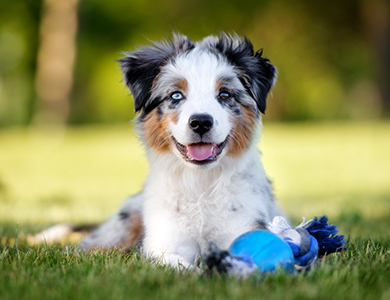
It is very important to carefully select the mating pair, as the cross-breeding of two merle dogs can have dire consequences. The double merle, or homozygous merle occurs when the offspring of two merle parents inherit two copies of the dominant merle gene. Each puppy from such a litter has a 25% chance of being born a double merle. Double merle puppies are at high risk of being born deaf and/or blind, and with a number of other medical complications, including epilepsy.
The average lifespan of the Australian shepherd is between 11 and 13 years.
Energy level and Temperament
Dogs of this breed are typically very energetic; they require a great deal of attention and plenty of exercise. Australian shepherds enjoy working and are most happy when stimulated, both physically and mentally. They may become destructive and bark for lengthy periods of time if they do not get the exercise and mental stimulation they require. Australian shepherds may display reserved and cautious guarding behaviours, but are kind and loving dogs that are devoted to those they know.
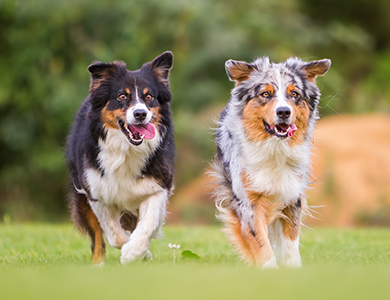
The Australian shepherd has a reputation for being a highly intelligent and versatile breed dog. It requires a minimum of 30 to 60 minutes of high-intensity daily exercise and does not adapt well to apartment living.
Grooming
Australian shepherds have a medium-length water-resistant coat. They shed regularly throughout the year, although not excessively. The Australian shepherd should be brushed at least once a week to maintain a healthy and clean coat and to prevent the undercoat from matting and tangling. If the coat is dirty, a bath can be given, but it is important to ensure that the coat is completely dry after the bath to prevent moisture from being trapped by the undercoat at the skin surface, which might cause skin problems.
For more information, contact a breeder who is registered with the Canadian Kennel Club, who will gladly answer all your questions. You may also contact the club to receive information about the breeders and the various breed clubs in Quebec and across the country.


